NREL Water Power Newsletter, The Current, Summer 2023
Catch up on NREL water power news and events, including a virtual island run on water power, the creators of the Spark Squad comic book series, and the winners of two recent collegiate competitions.
This quarterly newsletter highlights the latest from NREL's Water Power Program.
Subscribe To Newsletter
To receive quarterly updates about NREL water power news, accomplishments, events, and more, subscribe to The Current newsletter.
SUBSCRIBEIn This Issue
Take a Trip to Renewable Energy Discovery Island
Announcements
How Deep Is Your Ocean Love?
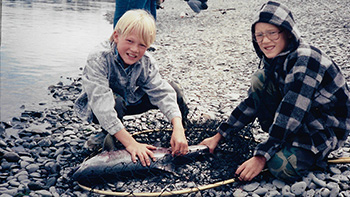
For most of his life, Levi Kilcher (left, with his brother Eivin) has been mesmerized by the ocean’s “silvery dance.” Photo by Sharon McKemie-Bauer
Take a Trip to Renewable Energy Discovery Island
Tour a Virtual Island Run on Water Power
Welcome to the Renewable Energy Discovery (REDi) Island, an educational virtual world powered entirely by renewable energy. REDi Island is home to a dozen water power waystation animations, such as these animated videos: Desalination Station, the Hydro Hollow, and Tidal Town. The animated videos demonstrate marine energy and hydropower applications to engage students and increase water power awareness. Stay tuned for more features coming soon, including an interactive app.
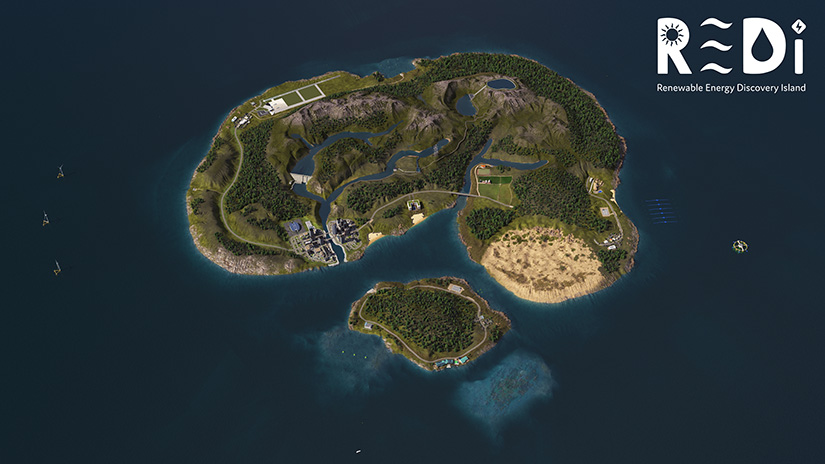
Hydropower News
New Tool Provides Accurate Building Cost Estimates for Pumped Storage Hydropower Facilities
NREL researchers released a new tool that can evaluate the potential construction and labor costs associated with building new closed-loop pumped storage hydropower plants—few of which have been built since the 1970s due to high upfront costs. The NREL team created the tool to allow users to select a wide range of desired system characteristics and to account for local geology, labor rates, and inflation, among other factors. The resulting cost estimation will provide grid planners with a more accurate picture of how many pumped storage hydropower facilities could reasonably be built over the coming decades.
NREL Releases New Tool to Evaluate Hydropower Plants Before They’re Built
The hydropower industry is often hindered from adopting new technologies since building hydroelectric prototypes can be risky, time-consuming, and expensive—until now. Researchers at NREL are designing a platform called Rapid Prototyping of Next-generation Hydro-controls (Hydro Emulation), which incorporates Advanced Research on Integrated Energy Systems (ARIES), one of the U.S. Department of Energy’s (DOE's) largest digital grid simulation platforms, to virtually mimic how hydropower plants might pair up with energy storage and other renewable energy technologies to provide more reliable energy to the grid. The goal of the tool is to provide a way to validate technologies that cannot be easily built and validated in the field to ultimately help utilities reconfigure their local hydropower plants and grid to better serve customers, especially in the face of potential power outages.
Take a Virtual Tour of Pumped Storage Hydropower in Action
Pay a visit to Hydro Heights, part of Renewable Energy Discovery (REDi) Island and see exactly how pumped storage hydropower works. Pumped storage hydropower systems, like the one seen in Hydro Heights, already provide 93% of the United States’ grid-scale energy storage. This virtual animated tour demonstrates pumped storage hydropower’s energy-storage capabilities that will make sure communities have access to reliable, resilient, and affordable electricity as more renewables are integrated into the grid.
Marine Energy News
NREL Supports Advancement of Marine Energy Technologies
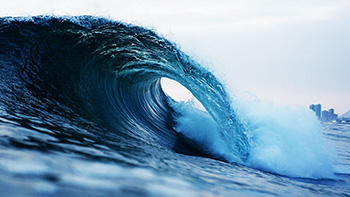
Ocean waves hold the potential to provide Americans with clean, reliable, renewable energy. Photo from Emiliano Arano, Pexels
NREL Helps Outline Path for Remote Alaskan Village To Achieve Sustainability Goals
After 20 years of planning, leaders of the remote Alaskan village of Igiugig—along with partners at NREL and Deerstone Consulting—published a new case study called Igiugig’s Journey to Sustainability. In 2000, Igiugig completed its first plan to build a more sustainable community that ran primarily on renewable energy. Now, the collaborative team, which was funded by WPTO and included NREL’s Becki Meadows and Levi Kilcher, has developed a more comprehensive strategy to help the villagers assess all their energy options, both in the short and long term. This strategy includes energy generated from river currents and other renewable energy resources as well as several high-priority steps—like ensuring community buildings are energy-efficient—that could help the village meet its goal to reduce diesel fuel use by 50% by 2030.
Marine Energy Atlas Earns Feature in 2022 Advanced Computing Annual Report
The Marine Energy Atlas—a publicly available tool that compiles data on marine energy resources available in specific ocean sites—was featured in NREL’s 2022 Advanced Computing Annual Report. The report celebrated the atlas’ new features, which include more hindcast (or historical) data on waves and a capacity factor tool, which gives users the ability to estimate how much electricity their specific device could produce. The Marine Energy Atlas was created by NREL, Sandia National Laboratories, and Pacific Northwest National Laboratory with funding from the WPTO.
Watch How Seawater Becomes Drinking Water Via Wave-Powered Desalination
Explore Desalination Station, another stop on REDi Island, to see an NREL-developed model of a desalination plant that can produce clean drinking water using energy generated from ocean waves. The virtual tour of the station demonstrates the way marine energy can be used to help us find solutions to our growing water crisis.
Prizes and Competitions
New NREL-Administered Water Prize Seeks Designs To Harness Grid-Scale Power From Waves
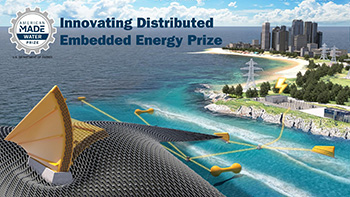
To ensure the competition’s success, competitors will receive support throughout the prize, including training in innovation methods, connections with commercialization mentors, and an introduction to marine renewable energy. Graphic by NREL
Climate Justice Champions Celebrated at Finale of Inclusive Energy Innovation Prize
The culmination of Phase Two of the American Made Inclusive Energy Innovation Prize took place June 13–14, 2023 on the NREL campus in Golden, Colorado. During the finale event, competitors presented their final pitches and shared all the ways they’ve been working with their communities to ensure a just and equitable clean energy transition. After their presentations, prize stakeholders had the opportunity to network with potential sponsors and forge connections that can deepen and extend the prize’s impact. At the conclusion of the event, six teams were named winners and awarded $250,000 each.
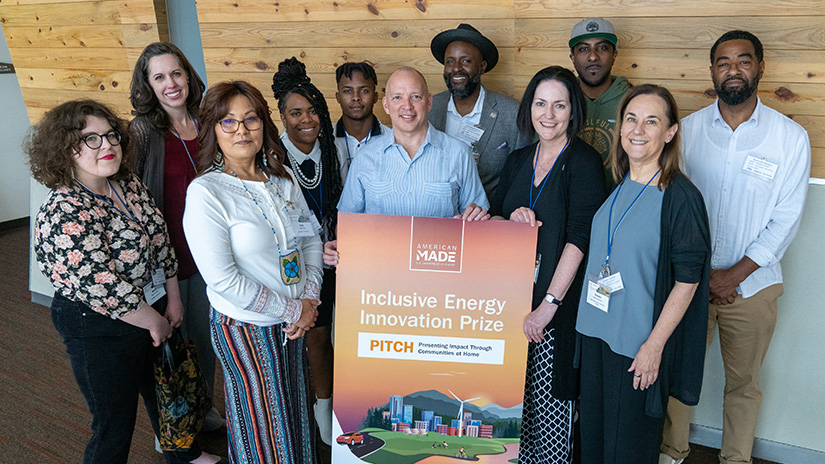
2023 Water Power Collegiate Competitions Winners Announced Following Water Power Week
DOE recently announced the winners of the 2023 American Made Hydropower Collegiate Competition and Marine Energy Collegiate Competition. The joint final event occurred during Waterpower Week 2023 in Washington, D.C. Endicott College and University of New Hampshire were the overall winners of the inaugural Hydropower Collegiate Competition and the fourth annual Marine Energy Collegiate Competition, respectively. DOE also announced the teams selected to participate in the 2024 Hydropower Collegiate Competition and Marine Energy Collegiate Competition. At the final event, students presented their work, connected with industry to gain mentorships and learn about potential career opportunities, and gained real-world experience. Administered by NREL, both competitions challenge undergraduate and graduate students to develop unique solutions to advance hydropower and marine energy technologies. Thanks to NREL’s coordinators Arielle Cardinal and Elise DeGeorge.
Beneath the Surface: The Spark Squad Behind the Spark Squad
How Cartoon Joules Are Capturing the Hearts and Minds of Tomorrow’s Clean Energy Workforce
If you’re a 1990s kid, you probably remember the punny Captain Planet with his teal mullet, anti-pollution tirades, and Earth-saving Planeteers. The cartoon was surprisingly successful, despite its didactic speeches and morose pandas. But now, as several of the show’s dire climate storylines—like a flood-prone, food-scare future—are seeping into reality, the super crew is long gone.
Gone, but not forgotten.
Captain Planet (plus turtles, flopping fish, and a chemist dad) inspired three now fully grown millennials to invent a super squad for a new generation. DOE's Spark Squad Comic Book series features three not-so-super-powered but just as powerful kiddos named Jasmine, Aria, and Thomas. The series first came out in 2022 and was developed by NREL and the DOE's WPTO.
Just like their creators, Heidi Tinnesand, Dale “Scott” Jenne, and Jenny Wiegele, these young Electriciteers are more practical than their predecessors. Instead of using five magic rings to call up a superhero, Jasmine, Aria, and Thomas capture joules (units of energy) to save themselves—and the world—one clean energy invention at a time.
“We liked this ‘everyday superhero’ vision of kids,” said Tinnesand, a mechanical engineer at NREL and the first spark to ignite the Spark Squad. “Superheroes don’t have to wear capes.”
Like their everyday superheroes, the spark squad behind the Spark Squad are a practical trio. They didn’t launch their comic series just to turn their day jobs into cartoon adventures; they had a bigger goal in mind. Today, too few kids are choosing to pursue clean energy careers. As the world ramps up production of clean energy technologies, like wind turbines, wave energy devices, and solar panels, the clean energy industry will need to grow a larger and more diverse workforce than we have today—to build an army of employees, as the World Economic Forum notes.
Without that army, we can’t properly fight climate change. And there’s no army without Electriciteers.
Read more about the Spark Squad team and the young Electriciteers.

Events and Opportunities
Visit the NREL Water Research Events page for more event information and registration details on upcoming workshops.
HydroVision International
July 11–13, 2023 (Charlotte, North Carolina)
HydroVision International brings together stakeholders in hydropower and marine energy along with dams/civil market professionals. The event includes symposia, knowledge hubs, and eight topic tracks: Civil Works and Dam Safety, Energy Storage (including Pumped Storage), Equipment and Technology, Market Trends and Asset Strategies, New Development (including Small Hydro), Operations and Maintenance, Policies and Regulations, and Water and Environment (including Social Issues).
Expanding Data Visualization for Next-Generation Pumped Storage Hydropower
July 18, 2023, Virtual
NREL recently released the 2nd generation of the first-ever U.S. resource assessment for closed-loop pumped storage hydropower, revealing new possibilities for pumped storage hydropower systems. With a new web-based visualization tool, this data set allows for in-depth exploration of potential pumped storage hydropower sites and their characteristics. This data set can help define how pumped storage hydropower can contribute to a decarbonized energy future for the United States. This webinar will include a live demonstration of the tool to help users understand how to explore and use the data.
NREL in the News
Could This Be the Final Frontier for Renewable Energy?, CNET (May 14, 2023)
How Collegiate Competitions Are Raising the Focus on Waterpower, Helping to Build the Future Workforce, National Hydropower Association PowerHouse (May 7, 2023)
Can Ocean Waves Power the Grid? New Technology is Bringing Us Closer Than Ever, Inverse (April 17, 2023)
Tidal Turbine Testing About To Start in Massachusetts, Offshore Energy (April 12, 2023)
A Woman, A Plan, A Canal…Hydrokinetic Energy!, CleanTechnica (April 11, 2023)
Flexible Desalination: A Renewable Energy Twist on the Energy-Water Nexus, Triple Pundit (April 3, 2023)
New Marine Energy Prize Investigates Novel Materials To Capture and Convert Wave Energy, EV Wind (April 1, 2023)
Hawaii Wave Surge Energy Converter Wave Energy Device Undergoes Sea Trials in Hawaii, Offshore Energy (March 24, 2023)
How To Be A “Good Ancestor,” CleanTechnica (March 19, 2023)
NREL’s Desalination Device Makes Waves, EcoWatch (March 9, 2023)
Publications
See all the latest publications, or explore these featured publications.
Deployment Readiness Framework Subtask 1.2 Outreach Report: Common Themes Among Clean Energy Transition Technical Assistance Projects, NREL Technical Report (2023)
Tanana River Test Site Model Verification Using the Marine and Hydrokinetic Toolkit, Energies (2023)
Influence on Structural Loading of a Wave Energy Converter by Controlling Variable-Geometry Components and the Power Take-Off, Journal of Offshore Mechanics and Arctic Engineering (2023)
Physics-Constrained Gaussian Process Model for Prediction of Hydrodynamic Interactions Between Wave Energy Converters In an Array, Applied Mathematical Modeling (2023)
Want More?
Subscribe to The Current to get the next water power newsletter in your inbox.
For the latest from the DOE WPTO, sign up for its water power newsletters. Have a more general question or can’t find what you’re looking for? Send us an email at water.power@nrel.gov.
Share

